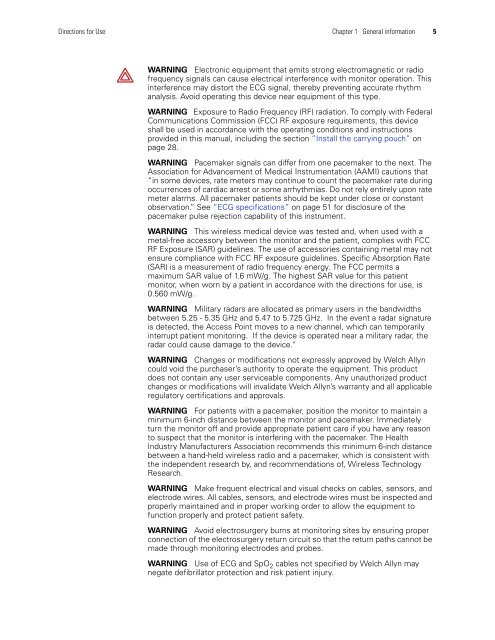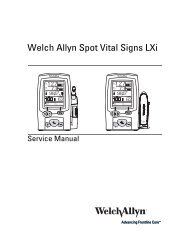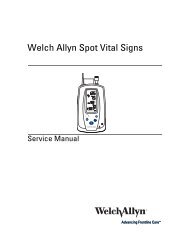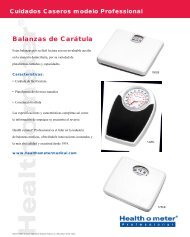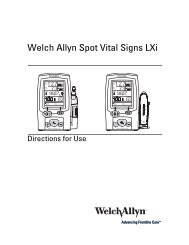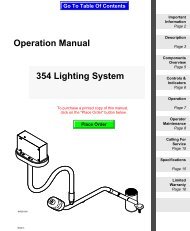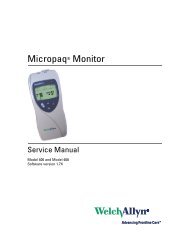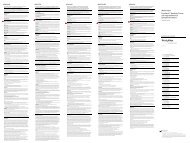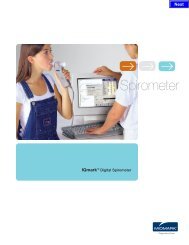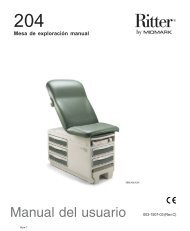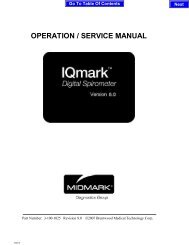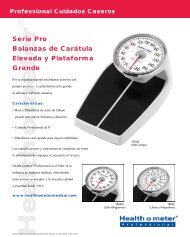Micropaq User Manual Model 406 and 408 - Medical Equipment Pros
Micropaq User Manual Model 406 and 408 - Medical Equipment Pros
Micropaq User Manual Model 406 and 408 - Medical Equipment Pros
You also want an ePaper? Increase the reach of your titles
YUMPU automatically turns print PDFs into web optimized ePapers that Google loves.
Directions for Use Chapter 1 General information 5<br />
WARNING Electronic equipment that emits strong electromagnetic or radio<br />
frequency signals can cause electrical interference with monitor operation. This<br />
interference may distort the ECG signal, thereby preventing accurate rhythm<br />
analysis. Avoid operating this device near equipment of this type.<br />
WARNING Exposure to Radio Frequency (RF) radiation. To comply with Federal<br />
Communications Commission (FCC) RF exposure requirements, this device<br />
shall be used in accordance with the operating conditions <strong>and</strong> instructions<br />
provided in this manual, including the section ”Install the carrying pouch” on<br />
page 28.<br />
WARNING Pacemaker signals can differ from one pacemaker to the next. The<br />
Association for Advancement of <strong>Medical</strong> Instrumentation (AAMI) cautions that<br />
“in some devices, rate meters may continue to count the pacemaker rate during<br />
occurrences of cardiac arrest or some arrhythmias. Do not rely entirely upon rate<br />
meter alarms. All pacemaker patients should be kept under close or constant<br />
observation.” See ”ECG specifications” on page 51 for disclosure of the<br />
pacemaker pulse rejection capability of this instrument.<br />
WARNING This wireless medical device was tested <strong>and</strong>, when used with a<br />
metal-free accessory between the monitor <strong>and</strong> the patient, complies with FCC<br />
RF Exposure (SAR) guidelines. The use of accessories containing metal may not<br />
ensure compliance with FCC RF exposure guidelines. Specific Absorption Rate<br />
(SAR) is a measurement of radio frequency energy. The FCC permits a<br />
maximum SAR value of 1.6 mW/g. The highest SAR value for this patient<br />
monitor, when worn by a patient in accordance with the directions for use, is<br />
0.560 mW/g.<br />
WARNING Military radars are allocated as primary users in the b<strong>and</strong>widths<br />
between 5.25 - 5.35 GHz <strong>and</strong> 5.47 to 5.725 GHz. In the event a radar signature<br />
is detected, the Access Point moves to a new channel, which can temporarily<br />
interrupt patient monitoring. If the device is operated near a military radar, the<br />
radar could cause damage to the device."<br />
WARNING Changes or modifications not expressly approved by Welch Allyn<br />
could void the purchaser’s authority to operate the equipment. This product<br />
does not contain any user serviceable components. Any unauthorized product<br />
changes or modifications will invalidate Welch Allyn’s warranty <strong>and</strong> all applicable<br />
regulatory certifications <strong>and</strong> approvals.<br />
WARNING For patients with a pacemaker, position the monitor to maintain a<br />
minimum 6-inch distance between the monitor <strong>and</strong> pacemaker. Immediately<br />
turn the monitor off <strong>and</strong> provide appropriate patient care if you have any reason<br />
to suspect that the monitor is interfering with the pacemaker. The Health<br />
Industry Manufacturers Association recommends this minimum 6-inch distance<br />
between a h<strong>and</strong>-held wireless radio <strong>and</strong> a pacemaker, which is consistent with<br />
the independent research by, <strong>and</strong> recommendations of, Wireless Technology<br />
Research.<br />
WARNING Make frequent electrical <strong>and</strong> visual checks on cables, sensors, <strong>and</strong><br />
electrode wires. All cables, sensors, <strong>and</strong> electrode wires must be inspected <strong>and</strong><br />
properly maintained <strong>and</strong> in proper working order to allow the equipment to<br />
function properly <strong>and</strong> protect patient safety.<br />
WARNING Avoid electrosurgery burns at monitoring sites by ensuring proper<br />
connection of the electrosurgery return circuit so that the return paths cannot be<br />
made through monitoring electrodes <strong>and</strong> probes.<br />
WARNING Use of ECG <strong>and</strong> SpO 2 cables not specified by Welch Allyn may<br />
negate defibrillator protection <strong>and</strong> risk patient injury.


